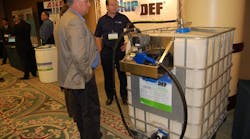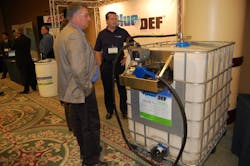Now that all of North America’s truck and engine makers are using selective catalytic reduction (SCR) technology to vastly reduce exhaust pollution, it’s probably a good time to revisit one of the key ingredients in the SCR process: diesel exhaust fluid or DEF.
Comprised of 67.5% water and 32.5% automotive grade urea, DEF is sprayed in small amounts into a truck's exhaust stream, whereby it helps convert ozone-causing oxides of nitrogen (NOx) into harmless nitrogen gas (N2) and water vapor (H2O).
[The video clip below provides a nice synopsis of how the entire emission control system works on a 2010-compliant truck – in this case one powered by a 15-liter Cummins engine.]
In essence, DEF plays a critical role in making the air coming from a truck's tailpipe cleaner than the air going into its engine, noted David McKenna, powertrain marketing manager for Mack Trucks, in an interview not long ago. [You can read more of that particular story by clicking here.]
That’s why, by extension, truck owners large and small are keeping a close eye on DEF pricing since it’ll maintain an ongoing impact on a commercial vehicle’s operating cost parameters.
So far, DEF prices are holding steady in the U.S. According to the latest figures tracked by global consulting firm Integer Research via its DEF Tracker service, the U.S. DEF pump price fell by one cent to $2.76 per gallon between August and September.
Meanwhile, the national Canadian DEF pump price remained largely unchanged at 79 cents per liter during the same time span (which is roughly equivalent to $3.15 per gallon in the U.S.), according to the company’s data.
[If you’ve got handling and resupply questions concerning DEF, a good place to get information in video format is the Air1/Yara YouTube DEF playlist. An example of what you’ll find there is below.]
Christopher Goodfellow, one of Integer’s analysts, noted that relatively stable raw material costs helped reduced volatility in DEF pricing over the past two months, particularly in truck stop pump and tote sales formats.
“We’ve also seen an increasing number of fleets installing mini-bulk DEF storage units and purchasing larger volumes of DEF,” he told me via email.
“Our research suggests that fleets receive a discount of around 7% to 10% when moving from a scenario in which their DEF supplier refills totes on site to one where they have a permanent bulk storage facility in place,” he added.“This discount increases further if fleets are able to take full truck load deliveries of DEF, although this is rare,” Goodfellow pointed out. “Clearly there is a capital cost involved in making installations of this kind, but fleets using larger volumes of DEF can get a good return and the number embracing this strategy increases. That being said, though, totes remain the most prevalent DEF supply format.”
He also noted that an additional 30 truck stop locations added bulk DEF dispensing facilities during this past September, including two additional locations in Canada, bringing the total number of truck stops offering DEF at the pump to 652.
Let’s just hope that as DEF expands in availability, pump prices for the yellowish ammonia-smelling liquid don’t start creeping up.




